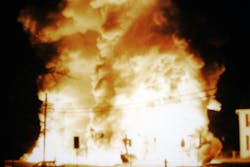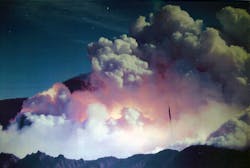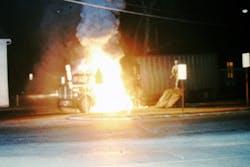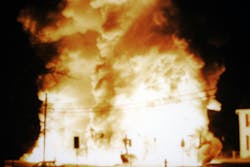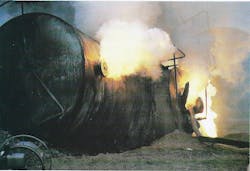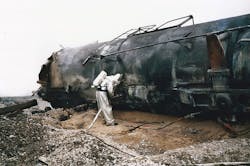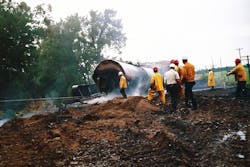Several major incidents have occurred over the years involving white phosphorus; two train derailments involving tank cars and one incident involving a box truck carrying 55-gallon drums. Phosphorus is transported and stored as a solid or in a molten form. It is a common hazardous material with many commercial uses. If encountered, it provides many unique challenges to emergency responders and presents dangers not only to responders but to the public.
Phosphorus is an air-reactive, naturally occurring metallic element that is a solid up to 111 degrees F. It is found as an ore in rocks and minerals and does not become air reactive until refined into pure phosphorus. Two forms are known to exist: white (sometimes called yellow) and red. White phosphorus has a waxy consistency and causes severe burns in contact with skin. If exposed to light, it turns dark. Phosphorus glows in the dark and spontaneously combusts in contact with air at 86 degrees F in moist conditions and 95 degrees–115 degrees F in dry conditions. Because of this reaction, it is transported and stored under water to keep it from contact with air. Once fires involving phosphorus are extinguished, they can re-ignite if the phosphorus is still exposed to air. One method of preventing re-ignition is to cover the phosphorus with wet sand or wet dirt.
White phosphorus is used in the manufacture of flares and incendiary devices, various military munitions and as a smoke agent (because it produces clouds of irritating white smoke). However, the largest use of white phosphorus is as a fertilizer. Ammonium phosphate is made from phosphorus ores. Ammonium phosphate should not be confused with ammonium nitrate, another fertilizer, which is a potential explosive when on fire. It is water soluble, non-explosive but will burn, giving off toxic fumes of ammonia and oxides of nitrogen.
Contaminated clothing should be removed to prevent re-ignition. Skin exposed to white phosphorus requires irrigation of the contaminated areas or placement of water or saline soaked pads. If the area becomes dry, it can re-ignite. Removal requires care to prevent further contamination of the person or responders. After complete removal, the victim can be treated as a burn patient.
Red phosphorus is non-toxic, non-reactive and fairly harmless. It is a solid used in the manufacture of matches. When formed into a chemical compound with iron, ferrophosphorus is an ingredient in high-strength low alloy steel.
Incidents involving phosphorus
Brownson, NE, April 2, 1978: Train Derailment with Phosphorus Fire & Explosion
Brownson, NE, is an unincorporated village located approximately five miles west of Sidney on U.S. Highway 30. Union Pacific Train 142 was eastbound with 101 cars when the derailment occurred. A total of 31 cars left the tracks, including a liquid tank car carrying white (yellow) phosphorus. The phosphorus car turned over and approximately half of the water covering the phosphorus leaked from the tank. Immediately, the phosphorus ignited and started to burn vigorously. No water supply was available, so the decision was made to allow the fire to burn. After consultation with NFPA action guides and the Chemical Transportation Emergency Center (CHEMTREC), firefighters were advised that there was no hazard of the tank car exploding. They were given three options by CHEMTREC to deal with the burning tank car: they could deluge the tank with large volumes of water (however, this was not possible because of the remote location of the derailment and no water source readily available); they could bury the car with sand and keep the sand wet, which would block the phosphorus from getting to the air; or, they could let the tank burn (which they chose to do). However, the wind speed and direction abruptly changed. Winds were now gusting to 30 miles per hour, blowing the toxic cloud towards Sidney. Evacuation of the north side of Sidney was undertaken as a precaution. Then, without warning, the tank car exploded, and parts of the tank car were propelled 2,400 feet away. Even though firefighters were in close proximity, no one was killed in the blast. Six railroad employees were injured.Hazmatology Point: Everyone was correct in terms of the phosphorus not causing an explosion in the tank car. Then what caused the explosion? The very thing they didn’t have enough of to fight the fire ended up causing the explosion. Phosphorus being air reactive is shipped under water in the tank thus keeping the phosphorus from spontaneously combusting. When the water leaked off, the phosphorus ignited and continued to burn, all the while heating the remaining water in the tank.
When water is heated to the point of boiling it becomes a gas (steam). Since this was a liquid tank it was not designed to hold pressure. When the steam pressure built up to the point the tank could no longer hold it, the tank came apart, explosively. This was a simple boiler explosion. When dealing with hazardous materials incidents, be sure to consider ALL the actors. In this case, in addition to the phosphorus, the tank and the water were also actors; actors that precipitated the explosion.
Gettysburg, PA, March 22, 1979: Phosphorous Truck Fire & Explosion
During the night of March 22, 1979, a truck transporting phosphorus through the town of Gettysburg, PA, stopped on Buford Avenue just west of the downtown business district when the driver noticed smoke coming from the cargo space of the truck. The truck was hauling white phosphorus in 55-gallon drums covered with water. One of the barrels developed a leak and water covering the phosphorus dropped below the level of the material in the drum. At that point the phosphorus ignited and burned, impinging on other drums on board. This repeated like a chain reaction until the entire truck was ablaze on the streets of Gettysburg.Hazmatology Point: Remember that 55-gallon drums are used for many chemicals, including acids, poisons, flammable liquids and solids. They do not carry gases because they are liquid containers. Anytime 55-gallon drums are exposed to fire, expect pressure build-up in the containers that may cause them to explode when the pressure causes the container to fail.
Miamisburg, OH, July 8, 1986: Derailment Causes Phosphorus Fire
On July 8, 1986, a southbound Baltimore and Ohio Railroad Company (B&O) freight train Southland Flyer (FLFR) derailed near Miamisburg, OH. The train was made up of a locomotive and 44 cars traveling over the Bear Creek Bridge. The locomotive and 27 cars made it over the trestle, remaining coupled together, but as the next 11 cars moved over the trestle, they derailed.A general alarm was sent out over pagers to call in all firefighters from the Miamisburg Fire Department (now a part of the Miami Valley Fire District). At the time of the derailment, Miamisburg had a population of 16,000. The Miamisburg Fire Department consisted of 23 career personnel and 14 reserves. Seven personnel along with the fire chief and fire inspector were on duty that day. They operated from two fire stations with two engines, two ladders, the air unit, brush unit, three medics and two reserve engines.
Firefighter/Paramedic Steve Meadows, now a battalion chief, was off duty and came into town. He noticed the train had stopped and thought that was unusual. He saw Capt. Mike Sutton driving Engine 3, got in and heard there was a derailment. Sutton had responded from the station with three firefighters. When they arrived on scene, they immediately began evacuations of a few homes around the derailment site.
Sutton checked with the railroad conductor and was told there was only one car containing a hazardous material, a tank car of white phosphorus, which was the one on fire. There were minor explosions occurring, which may have been the gas tanks of automobiles of the two car carriers that derailed. Near the phosphorus car were a tank car of animal fat (which was leaking into the creek) and a box car of rolled paper, neither of which were involved in the fire. Several holes developed in the tank during the impact of the derailment and the water started leaking, causing the phosphorus to be exposed to air and it ignited.Meadows stayed with Engine 3 and ran the pump full throttle for two hours before he was relieved. Within two hours, 3,200 gpm of water was being pumped through four master streams onto the fire. Water supply was an issue because hydrants were not close. Four-inch hose was used with inline pumpers to supply water. Firefighters in or near the phosphorus cloud wore SCBA, which was refilled by the air cascade system. The air truck had to be taken to West Carrolton to be filled as they were using a lot of air.
Andy Harp (now a battalion chief) and his partner, Leroy Kline, heard the call on the radio and went to the scene in their medic unit. There was a 100-foot column of white smoke rising from the derailment site.
Firefighter Billy Ring was off duty at home when a neighbor told him about the chemical spill. He called the station, and no one answered. He called dispatch and was told everyone was needed, so he responded to Station 1. During the incident, Ring was asked to take an aerial survey of the scene and a news helicopter took him up.
Robert Menker (who has since passed away) was the fire chief and incident commander at the time of the incident. When he arrived on scene, he ordered an immediate evacuation of the west side of the Great Miami River. After an evaluation of the incident status, Menker ordered the northeast section of town evacuated as well. This amounted to about 10,000 people being evacuated. There were no security issues, and there was no looting during the evacuations. Miamisburg looked like a ghost town. Following consultation with other chiefs it was decided to mount an attack on the fire utilizing water cannons and direct hose streams. The next day, the wind direction changed and, coupled with a temperature inversion that kept the phosphorus cloud close to the ground, it prompted a second evacuation affecting approximately another 30,000 people.
During the first and second days of the emergency, numerous proposals for handling the phosphorous tank were suggested and evaluated, including opening the manhole to allow air injection to accelerate the burn rate. Menker, in consultation with the city manager, decided to proceed with the suggestion of opening the manhole.AT&T provided an emergency phone bank at the command post. An emergency operations center was established at Station 1, where logistics and support were being provided. By the time the emergency was declared under control, local hospitals received 569 persons with nonfatal injuries, including 13 emergency response personnel. Of these, 27 were hospitalized due to their injuries. The cost, excluding costs to evacuees, community disruption or business interruptions, was estimated to be more than $3.5 million.
Hazmatology Point: During interviews, I was told by fire department personnel that they could not have planned for a specific incident of this magnitude. There was no way of knowing where the incident might occur, what the circumstances surrounding the incident might have been and the size of the evacuation that was required because of the specific location. Despite a lack of specific planning, the incident was handled well because of the general training the department had involving incident command, firefighting and hazardous materials response.
My thanks to Battalion Chief Sharp, Battalion Chief Meadows and Firefighter Ring for interviews, tour of the site, photos and information on the incident.
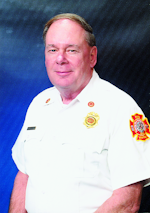
Robert Burke
Robert Burke, who is a hazardous materials and fire protection consultant and who served as a Firehouse contributing editor, is a Certified Fire Protection Specialist (CFSP), Fire Inspector II, Fire Inspector III, Fire Investigator and Hazardous Materials Specialist. He has served on state and county hazmat teams. Burke is the author of the textbooks "Hazardous Materials Chemistry for Emergency Responders," "Counter-Terrorism for Emergency Responders," "Fire Protection: Systems and Response," "Hazmat Teams Across America" and "Hazmatology: The Science of Hazardous Materials."
